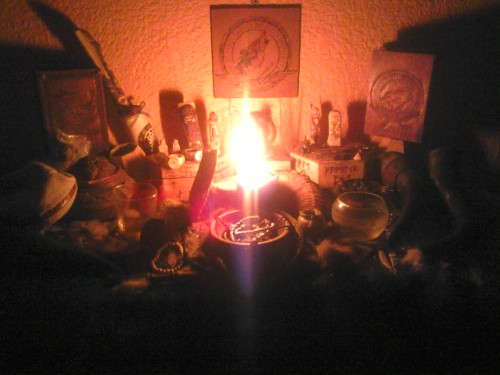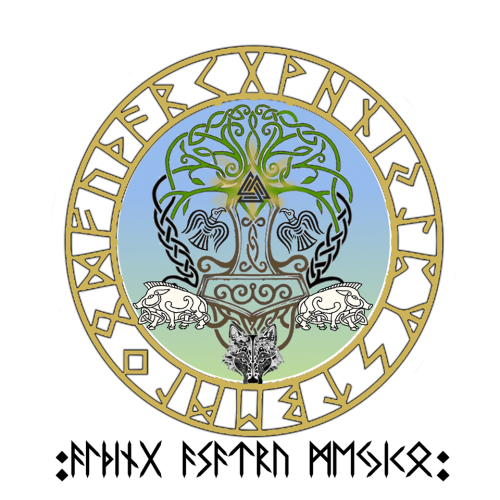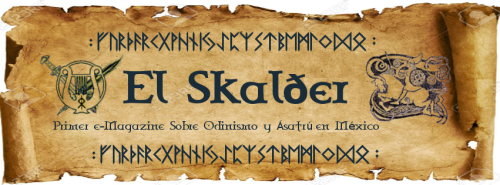MEXICO CITY — Nestled between Central America and the United States and extending from the Atlantic to Pacific oceans lies the country of Mexico, known for its rich culture, traditional foods and ancient history. Mexico is also known for supporting a deeply religious culture with the majority practicing Catholicism. In the most recent reports, 82.7% of its 128,109,966 residents identify as Catholic. But thriving within that dominant religious culture are a growing number of minority religions, which are now shifting a religious landscape that has held strong for centuries. One of these emerging religions is Asatru.

[Courtesy Photo Allthing Asatru Mexico]
Religiosity among Mexicans is not a fad or a recent invention; it is a constitutive dimension of the personal and historical identity of the Mexican people. Religiosity not only means the set of expressions and external activities that we conventionally associate with “religion”; it is a reference to the anthropological dimension that undertakes the search for the ultimate meaning of existence. One of the expressions of this religiosity – though not the only one- entails a steady decline in the percentage of the Catholic population in the country.
In his report, Dr. Patiño notes that, according to the “General Population Census of 2000,” 96.48 percent of Mexicans identify as being religious. But only 87.99 percent said that they were Catholic, which is down from 99.5 percent in the 1900 census. And today, that number is still lower, at only 82.7 percent. Despite the decrease in the Catholic population, there is very little decrease in religiosity, which supports Dr. Patiño’s observation on the importance of religion within Mexican society. It also points to the growth of minority religions.
“Heathenry in México is largely unknown and misunderstood for fashion or even a form of cosplay. The average Mexican barely knows Marvel’s Thor, let alone the old Norse religion,” explained Stracy Bryan Salazar Arellano, the Góði of Clan Úlfey Ásatrú Norsk Sed.
Founded in 2007, Clan Úlfey Ásatrú Norsk is the largest known kindred in Mexico. Salazar, who has been practicing Asatru for 14 years, was unanimously voted its Góði in 2008 and has been ever since. Outside of religious work, Arellano is a computer engineer and brewmaster at Brewery Brauerwolves and lives in the country’s capital, Mexico City. As Dr. Patiño noted in his report, “Religious diversity is not homogeneous across the country. It reaches different percentages at a regional, state and local level.” Most Heathens do live around Mexico City but not exclusively, and Salazar said that he makes an effort to travel around the country to meet other Asatru practitioners and kindreds.
![Stracy Bryan Salazar Arellano [Courtesy Photo]](https://wildhunt.org/wp-content/uploads/2016/03/10849762_1527365494200208_2768558610899073867_n-500x500.jpg)
Stracy Bryan Salazar Arellano [Courtesy Photo]
Salazar, who is also the Góði of Allthing Ásatrú México, said that its difficult to know exactly how many people are “serious Ásatrúar,” because there is a popular “viking metal crowd who wear the Mjölnir on their necks and think of the [Norse] tradition only like a fashion.” Despite the lack of clear data, he does see that their numbers are growing. Currently, Allthing has five member clans, including Clan SvarturDrekar, Clan del Oso, Clan Hijas de Gullveig, Clan Úlfar and Clan Úlfey Ásatrú Norsk Sed.
Speaking more specifically about the individuals, Salazar said, “Most of our members are Mexicans. Although there are few cases where they come from Europe or the U.S. As for religious background, most of our members come either from a Catholic background […] or from New Age religions.” He added that some members have “European ancestry, either German or Scandinavian.” In those cases, relatives, typically grandparents, “taught [them] the myths and legends and the lore.” Speaking generally about Allthing members, Arellano said, “We have some history and anthropology enthusiasts, medieval recreationists and practitioners of HEMA (Historical European Martial Arts) and HMB (Historical Medieval Battle),and others [found us] through music (mostly folk metal).”
When asked about their relationship to Mexico’s own heritage and ancient traditions, Salazar explained that the groups generally try to keep true to Norse mythology and lore, rather than creating an eclectic religious practice. He said, “We don’t mix rituals and elements of other traditions.” However, he did later say that the Aztec and Mayan cultures “were great and leave much cultural and traditional folklore,” adding: “We do give some offering to the local Gods in our Blotar, as they do allow us to work our ways in this Land.”
 Neither Allthing Ásatrú México nor the individual clans are currently members of any international Heathen organization. They generally keep to themselves. However, Salazar said that they “do have relations with some local groups such as those with “Mexican roots (aztec dancers or concheros, Mayan’s sorcerers and sorceresses)” and those practicing “Afro-Cuban witchcraft like Palo Mayombe.” He described such relationships as being based on friendly hospitality and not religious practice. Allthing Ásatrú México also maintains similar friendly relations with a few Heathen kindreds around the world.
Neither Allthing Ásatrú México nor the individual clans are currently members of any international Heathen organization. They generally keep to themselves. However, Salazar said that they “do have relations with some local groups such as those with “Mexican roots (aztec dancers or concheros, Mayan’s sorcerers and sorceresses)” and those practicing “Afro-Cuban witchcraft like Palo Mayombe.” He described such relationships as being based on friendly hospitality and not religious practice. Allthing Ásatrú México also maintains similar friendly relations with a few Heathen kindreds around the world.
Despite the heavy influence of Catholicism on Mexican culture, Salazar said that Asatruar rarely run into any problems. Their numbers are too small to be on the “radar” of the Catholic Church, or anyone else for that matter. Salazar said that the biggest problem facing Mexico’s kindreds is one of public image and not of religious freedom. He explained, “Here in Mexico many Nazi groups use Heathen symbolism with ignorance. You can see them with Mjölnir or Runes on their necks.” He said that Allthing is trying to “clean the Ásatrú and Odinist Image” and that, while all the member clans are autonomous and independent, they all must agree to stand against racism and white supremacy to be a member.
 Allthing’s latest outreach project is the launch of a monthly digital magazine called El Skalðr. This new magazine’s mission will be to “help spread and promote Ásatrú among all those Spanish speakers interested in it, in a clear and concise way.” Salazar described the scope as going as including, “culture and tradition from both Germanic and Scandinavian Heathenry, practice both in the past and in the present all over the world, archeology, anthropology and history, and news and events from the Heathen world.”
Allthing’s latest outreach project is the launch of a monthly digital magazine called El Skalðr. This new magazine’s mission will be to “help spread and promote Ásatrú among all those Spanish speakers interested in it, in a clear and concise way.” Salazar described the scope as going as including, “culture and tradition from both Germanic and Scandinavian Heathenry, practice both in the past and in the present all over the world, archeology, anthropology and history, and news and events from the Heathen world.”
The first issue of El Skalðr will be out in two weeks around the equinox and will feature articles “about the Ásatrú and Odinist History on Mexico, the difference between Odinism, Ásatrú and Wotanism.” It will also contain music recommendations, articles on Ostara and more.
When asked why the clans wanted to take on this project, Salazar said, “There are a number of websites and Facebook groups belonging to the Allthing Ásatrú México, some clans and some moderated by individual members dedicated to spreading the culture and tradition, and informing all those who want to learn about Ásatrú. We wanted to integrate these sources in one publication to make this more efficient.” He also said that there are issues and stories that are very specific to Spanish-speaking Heathenry that would be inappropriate for general forums and needed a dedicated place to “be addressed.”
And the larger Spanish-speaking Heathen community is the target audience. The magazine will be published only in Spanish with contributors, at this point, predominantly from Mexico. While, at first, the magazine will focus mainly on Mexican Heathenry, Salazar did say that they do hope to later “include issues concerning other Spanish speaking countries.”
![[Courtesy Photo]](https://wildhunt.org/wp-content/uploads/2016/03/11692505_1620018884934868_3708078733890816_n-500x375.jpg)
[Courtesy Photo]
As the members of Allthing are now preparing to launch their publishing venture, Salazar welcomes the growth and expansion. Reflecting on his own personal spiritual journey, he said that being a Góði is “hard work,” but he considers it a duty and a way to “honour [his] ancestors, [his] Gods and [his] family.” He added, “Í want to thank my grandfather Luciano Arellano to teach me this wonderful Tradition, to my brother and Clan co-founder Jorge Ballesteros, to all the Clan Úlfey members and the Allthing Ásatrú México Clans by their Support and at last þó my brother and Master Isaac Vázquez at the H.O.S.F.”
The magazine will be available on the Equinox in a downloadable, free PDF format. Look for it on Allthing’s website and Facebook page.
* * *
[Editor’s Note:This article is currently being translated into Spanish and will be made available in PDF form in the coming days. We will provide a link here and announce its availability in social media.]
The Wild Hunt is not responsible for links to external content.
To join a conversation on this post:
Visit our The Wild Hunt subreddit! Point your favorite browser to https://www.reddit.com/r/The_Wild_Hunt_News/, then click “JOIN”. Make sure to click the bell, too, to be notified of new articles posted to our subreddit.
Great news for religious diversity in Mexico! Though not a Heathen, I hope to have more news from this and other groups in my country.
Just a quick comment, Mexicans have two “last names” a paternal and a maternal and when using just one of them to talk about someone the correct usage is to call them by their paternal or “first” last name. So Dr. Alberto Patiño Reyes is Dr. Patiño, and Stracy Bryan Salazar Arellano is Salazar.
Thank you for your note on the last names. We are confirming with the interviewees and will make that correction immediately.
“While all the member clans are autonomous and independent, they all must
agree to stand against racism and white supremacy to be a member.”
Good for them.
Just as a merry mirror to Rubén’s statement, though I am not a Mexican I am very happy to see that Heathenry traces its way Southwards!
If some of you are French readers also, notice our modest group ‘les enfants d’Yggdrasill’. I hope to have the pleasure to read of some of you – or even to collaborate with them some day.
(hund heidhinn)
Pingback: Asatro uti Mexico – Den går mycket bra, må ni tro… | Hedniska Tankar
Pingback: El Skalð e-Magazine a la Mexicana. | El Diario de Odín